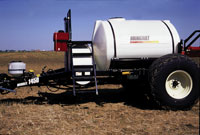
Precision Ag
Disposing of leftover herbicides and tank rinsing
Research into biobeds might offer a solution to left over sprays.
October 18, 2008 By Top Crop Manager
Research into biobeds might offer a solution to left over sprays.
What does a grower do with leftover herbicide spray or tank rinsing? For farmers with summerfallow, the answer is usually to spray it out on a summerfallow field. But what if there is no summerfallow? Well, recommendations are hard to find in any of the Provincial Crop Protection Guides or on labels.
“Disposal of herbicide waste can be a challenge for farmers. I’ve talked to a lot of farmers and they want to do the right thing, but recommendations are lacking,” says research scientist, Tom Wolf with Agriculture and Agri-Food Canada (AAFC) at Saskatoon, Saskatchewan.
The challenge with improper waste disposal is that leftover pesticide mixtures from a sprayer operation can contaminate wetlands, ponds, waterways or drinking water wells. Some pesticides also have a long persistence in the soil or water, so proper disposal is necessary to prevent contamination of the soil or groundwater.
 |
| Biobeds might help with the disposal of leftover spray solutions. |
One potential decontamination technique that has been used on European farms is called a biobed. A biobed can be established on farms near pesticide filling or sprayer washing sites. Generally, it is a clay-lined hole in the ground, measuring one metre deep and ranging in area from five to 50 square metres, filled with a mixture of topsoil (25 percent), peat or compost (25 percent) and straw (50 percent). Biobeds may be covered with a grass layer to maintain appropriate temperatures for microbial activity and a steel grid to support machinery.
The theory behind biobeds is that they present a more favourable environment for microbial activity to break down pesticide residues. Wolf says that the topsoil serves as the source for the micro-organisms in the system. The peat or compost is included for its high water-holding capacity and provides a large organic matter surface area for adsorption. The straw serves as a carbon source for lignin-degrading micro-organisms.
Biobeds provide excellent conditions for stopping the movement of pesticides into water sources by adsorbing the pesticide to the surfaces of the compost or peat, but still leaving the pesticides available for degradation. Because the adsorptive surfaces themselves can be degraded, the pesticides also continue to be degraded. The inclusion of straw is thought to select those micro-organisms that specialize in the degradation of recalcitrant materials like lignin (a major component of straw) and pesticides.
Water released from the biobed should then be significantly remediated. Studies in England have demonstrated that biobeds can effectively retain and degrade pesticides to a reduction rate of 10,000 to 1,000,000 fold.
At Saskatoon, Wolf, along with Diane Knight and Richard Farrell of the Soil Science Department at the University of Saskatchewan, and Allan Cessna with the National Water Research Institute of Environment Canada, initiated a research project in 2007 to see if biobeds have potential for pesticide disposal under western Canadian environmental conditions. In 2007, laboratory studies were conducted to assess the ability of biobeds to degrade the herbicide 2,4-D. The effects of substrate type, incubation temperature, moisture content, herbicide concentration and herbicide formulation were evaluated.
Preliminary laboratory results showed that the rate of herbicide breakdown in biobeds was increased by approximately three to six times compared to soil alone. 2,4-D degradation rates were somewhat greater when biobed substrate was previously inoculated with the same herbicide, but were not increased when alfalfa pellets were used to replace 50 percent of the straw component in the substrate. Low temperatures were detrimental to degradation, as expected, with little breakdown at five degrees C and the fastest breakdown at 25 and 35 degrees C.
While these results are promising, Wolf says much more research will be required to see if biobeds will work in western Canada. Indeed, research in other parts of the world shows the challenge in working with biobeds. For example, in practice, crops and field soils receive repeated applications of tank-mixes containing herbicides, fungicides and insecticides. Biobeds are therefore likely to receive complex mixtures of more than one active ingredient applied repeatedly, at concentrations far higher than field treatment rates.
In the UK, research found that when the pesticide active ingredients isoproturon, chlorothalonil, mecoprop-P and metsulfuron-methyl were applied to a biobed as a mixture, the time for 50 percent reduction in concentration values increased, indicating that interactions between pesticides applied as a mixture are possible and need to be investigated further.
At AAFC Saskatoon, in addition to the laboratory studies for 2008, six field scale incubators have been built to test biobeds on a larger scale. “The main lesson for now, is to make no assumptions that biobeds will work in western Canada,” says Wolf. “Before we can endorse biobeds, we have to look at it under our conditions to make sure it will work as expected. In the UK, for example, waterlogging was a major issue. Here, it might be something else, like low temperatures or unique
pesticide mixtures. Only a significant research effort will give the answers to those questions, but the initial results show that the concept has merit.”